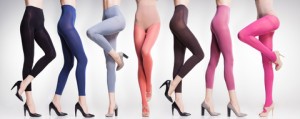What makes Footless Hosiery with Graduated Compression different from your Average Leggings and Footless Style Hosiery?
Many conventional leg garments feel more or less stretchy and clingy on your legs and some even seem to exert a certain degree of pressure (compression) on the lower extremities.
Countless women and a fair number of men like to wear these stretchy and comfy leggings or tights to look slimmer, more toned or for health reasons because they may help to alleviate some type of pain or discomfort in the legs.
Most footless or footed types of leggings, tights and pantyhose are made of the same kinds of fibers and elastic materials – commonly known as Nylon and Lycra (or Spandex). The Lycra or Spandex content in these garments is usually between 3 and 10%. The higher the percentage of Lycra or Spandex is, the stretchier and clingier the hosiery product will be on your legs.
One could easily conclude that any type of highly stretchy leggings or footless pantyhose could do the trick to provide compression for your legs. Even if your legs are generally healthy, you may still be able to get some invigorating and energizing benefits from wearing stretchy leggings or footless tights with light compression similar to support pantyhose.
However, to obtain real compression support for your legs it takes more than just some added Spandex fibers.
Graduated Compression Leggings and other Footless or Footed Hosiery is very Different
 You probably guessed it. The magic word is “graduated” or “gradient” compression, which stands synonym for moving up or progressing upwards.
You probably guessed it. The magic word is “graduated” or “gradient” compression, which stands synonym for moving up or progressing upwards.
In most cases normal type leggings, tights or other leg fashion hosiery do not feature graduated compression.
Graduated compression leggings, tights, pantyhose and stockings are uniquely designed hosiery products.
They are characterized by much higher percentages of Lycra or Spandex content, ranging anywhere from 12% to over 30% depending on how much graduated compression the final hosiery product must provide for the wearer.
In addition, highly sophisticated knitting processes ensure that the compression of the stocking or hose is “graduated”. This means the compression on the leg is the strongest beginning at the ankle area and decreases gradually going up the leg to the top of the stocking.
For more information about the different pressure classes of graduated compression hosiery please go to our article A Closer Look At Compression Classifications
If you have looked at graduated compression leggings, footless tights, pantyhose and other compression hosiery before you already know that they are more expensive than your everyday type leggings and support pantyhose.
More involved knitting processes plus the necessity of a higher Lycra or Spandex content in the hosiery account for the higher price range of these garments compared to conventional type hosiery. Additionally, graduated compression legwear must undergo specific testing and quality control measures to ensure they provide the proper levels of compression to the ankle, calf and thigh areas of the leg.
Most of us spend many of our waking hours standing or sitting. If you experience heaviness, fatigue, leg pain, cramps or swelling towards the end of your day, or if you have mild varicose veins or spider veins, your leg health may be at risk.
If any of the described symptoms ring true for you and you would like to enjoy your summer months without them, your legs could benefit from the relieving and energizing effects graduated compression leggings and other footless compression hosiery can provide. It is a known fact that especially during the hot summer months the vein system in your legs is subject to increased stress and potentially damaging effects from the heat.
Caution: As with anything that could affect your health, check with your physician first before making any changes and make sure that you do not have any conditions where compression stockings would not be right for you.
